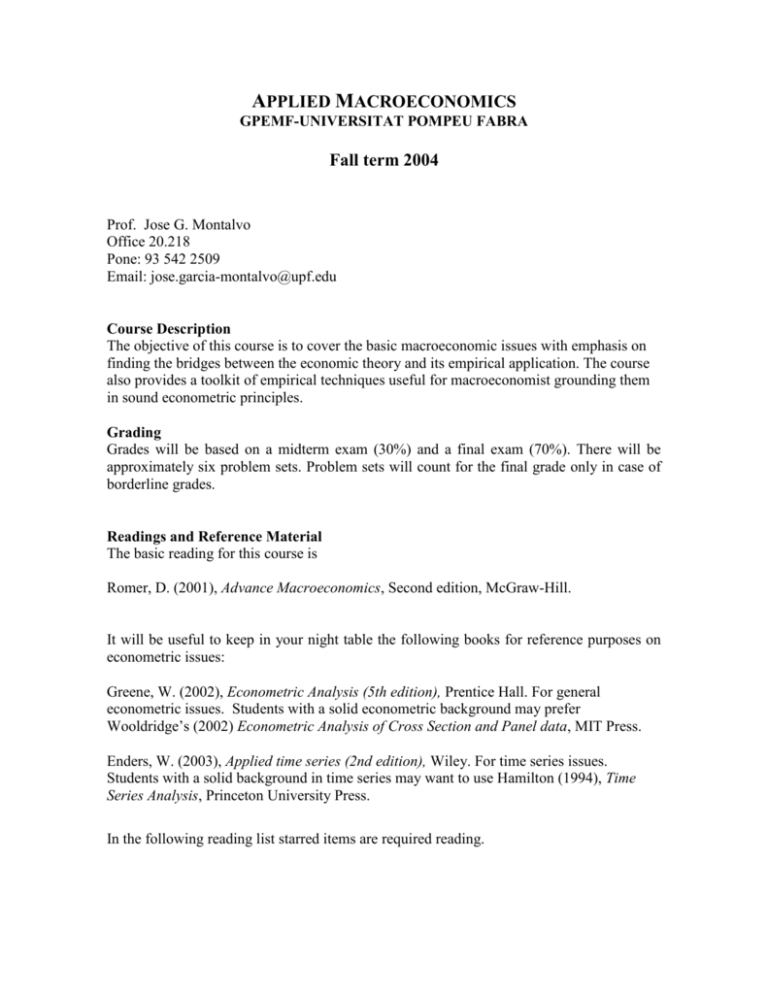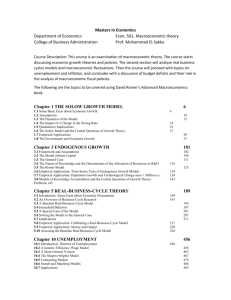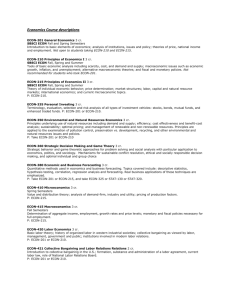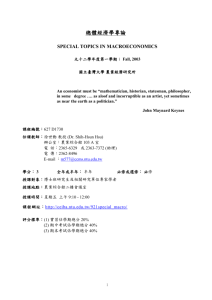Program. - Universitat Pompeu Fabra
advertisement

APPLIED MACROECONOMICS GPEMF-UNIVERSITAT POMPEU FABRA Fall term 2004 Prof. Jose G. Montalvo Office 20.218 Pone: 93 542 2509 Email: jose.garcia-montalvo@upf.edu Course Description The objective of this course is to cover the basic macroeconomic issues with emphasis on finding the bridges between the economic theory and its empirical application. The course also provides a toolkit of empirical techniques useful for macroeconomist grounding them in sound econometric principles. Grading Grades will be based on a midterm exam (30%) and a final exam (70%). There will be approximately six problem sets. Problem sets will count for the final grade only in case of borderline grades. Readings and Reference Material The basic reading for this course is Romer, D. (2001), Advance Macroeconomics, Second edition, McGraw-Hill. It will be useful to keep in your night table the following books for reference purposes on econometric issues: Greene, W. (2002), Econometric Analysis (5th edition), Prentice Hall. For general econometric issues. Students with a solid econometric background may prefer Wooldridge’s (2002) Econometric Analysis of Cross Section and Panel data, MIT Press. Enders, W. (2003), Applied time series (2nd edition), Wiley. For time series issues. Students with a solid background in time series may want to use Hamilton (1994), Time Series Analysis, Princeton University Press. In the following reading list starred items are required reading. READING LIST I. LONG RUND MACROECONOMICS 1. Economic growth. *Romer (2001), chapters 1 and 2.1-2.7. *Mankiw, G., Romer, D. and D. Weil (1992), “A contribution to the empirics of economic growth,” Quarterly Journal of Economics, CVII, 407-437. *Easterly, W. and R. Levine (1997), “Africa’s growth tragedy: policies and ethnic divisions,” Quarterly Journal of Economics, 112, 1203-1250. Barro, R. and X. Sala-i-Martin (2004), Economic growth, MIT Press. Chapters 1, 2-4, 11 and 12. Barro, R. (1997), Determinants of economic growth: a cross-country empirical study, MIT Press. Caselli, F., Esquivel, G. and F. Lefort (1996), “Reopening the convergence debate: a new look at cross-country growth empirics,” Journal of Economic Growth, 1, 3, 363-389. Durlauf, S. and P. Johnson (1995), “Multiple regimes and cross-country convergence,” Journal of Applied Econometrics, 10, 365-384. Levine, R. and D. Renelt (1992), “A sensitivity analysis of cross country growth regressions,” American Economic Review, 82, 4, 942-963) Quah, D. (1996), “Growth and Convergence in models of distribution dynamics,” Economic Journal, 106, 1045-1055. Doppelhofer, G., R. Miller and X. Sala-i-Martin (2000), “Determinants of long term growth: a Bayesian averaging of classical estimates (BACE),” NBER WP 7750. 2. New theories of economic development. *Acemoglu, D., S. Johnson and J. Robinson (2001), “The colonial origins of comparative development: an empirical investigation,” American Economic Review, 91, 5, 1369-1401. *Frankel, J. and D. Romer (1999), “Does trade cause growth?,” American Economic Review, 89, 3, 379-399. Acemoglu, D., S. Johnson and J. Robinson (2002), “Reversal of fortunes: geography and institutions in the making of modern world income distribution” Quarterly Journal of Economics, 117, 1231-1294. Easterly, W. and R. Levine (2003), “Tropics, germs and crops: how endowments influence economic development,” Journal of Monetary Economics, 50. Hall, R. and C. Jones (1999), “Why do some countries produce so much more output per worker than others?,” Quarterly Journal of Economics, 114, 83-116. 3. Productivity analysis. *Hall, R. (1990), “Invariance properties of Solow’s productivity residual,” Growth/ productivity/Unemployment: Essays to Celebrate Bob Solow’s Birthday, Ed.: P. Diamond, MIT Press. *Barro, R. (1999), “Notes on growth accounting,” Journal of Economic Growth, 119137. Jorgenson, D. and Z. Griliches (1967), “The explanation of productivity change,” Review of Economic Studies, 34, 99, 249-280. Fernald, John G., Basu, Susanto, Shapiro, Matthew D. (2001), "Productivity Growth in the 1990s: Technology, Utilization, or Adjustment?" Carnegie-Rochester Conference Series on Public Policy, 55(0), pp.117-165. Basu, S. and J. Fernald (1997), “Returns to scale in U.S. production: estimates and implications,” Journal of Political Economy, 105, 2, 249-283. Hall, R. (1988), “The relationship between price and marginal cost in U.S. industry,” Journal of Political Economy, 96, 921-947. Jorgenson, D. and K. Stiroh (2000), “Raising the speed limit: U.S. economic growth in the information age,” Brookings Papers on Economic Activity, 125-211. Oliner, S. and D. Sichel (2000), “The resurgence of growth in the late 1990’s: Is information technology the story?,” Journal of Economic Perspectives, 14, 4, 322. Hamilton, J. and J. Monteagudo (1998), “The augmented Solow model and the productivity slowdown,” Journal of Monetary Economics, 42, 495-509. II. CYCLES AND ECONOMIC FLUCTUATIONS 4. Classical and Keynesian models. Sources of economic fluctuations: RBC versus New Keynesian models *Romer (2001), chapters 4.1-4.5 and 5.1, 5.3-5.4. Hodrick, R. and E. Prescott (1997), “Postwar US business cycles: an empirical investigation,” Journal of Money, Credit and Banking, 29,1, 1-16. Campbell, J. and Perron (1991), “What macroeconomist should know about unit roots,” NBER Macroeconomics Annual, MIT Press. R. King, Plosser, Stock, J. and M. Watson (1991), “Stochastic trends and economic fluctuations,” American Economic Review, 81, 819-840. King, R. and C. Plosser (1982), “Trend and random walks in economic time series: some evidence and implications,” economic fluctuations in economic variables,” Journal of Monetary Economics, 139-162. *Stock, J. and M. Watson (1988), “Variable trends in economic time series,” Journal of Economic Perspectives, 147-174. Blanchard (1981), “Output, stock markets and interest rates,” American Economic Review, 132-143. Shea, J. (1998), “What do technology shocks do?,” NBER Macroeconomics Annual, 275-310. 5. Consumption. *Romer (2001), sections 7.1-7.6. Hall, R. (1978), “Stochastic implications of the life cycle-permanent income hypothesis: theory and evidence,” Journal of Political Economy, 971-987. Chang-Tai, H. (2003), “Do consumers react to anticipated income changes? Evidence from the Alaska permanent fund,” American Economic Review, 397-405. *Gross, D. and N. Souleles (2002), “Do liquidity constrains and interest rates matter for consumers behavior? Evidence from credit card data,” Quarterly Journal of Economics, 149-185. Mehra, R. and E. Prescott (1985), “The equity premium: a puzzle,” Journal of Monetary Economics, 15, 145-161. Carroll, C. (1992), “The buffer-stock theory of savings: some macroeconomic evidence,” Brookings Papers on Economic Activity, 1992:2, 61-165. Angeletos, G., Laibson, D., Repetto, A., Tobacman, J. and S. Weinberg (2001), “The hyperbolic consumption model: calibration, simulation and empirical evaluation,” Journal of Economic Perspectives, 47-68. Stock, J. (1988), “A reexamination of Friedman’s consumption puzzle,” Journal of Business and Economic Statistics, 6, 4, 401-414. 6. Investment. *Romer (2001), chapter 8.1-8.6. *Cummins, J., Hassett, K. and G. Hubbard (1994), “A reconsideration of investment behavior using tax reforms as natural experiments,” Brookings Papers on Economic Activity, 1994:2, 75-138. Caballero, R. (1999), “Aggregate investment,” Handbook of Macroeconomics, 815840. *Caballero, R., Engel, E. and J. Haltiwanger (1995), “Plant level adjustment and aggregate investment dynamics,” Brookings Papers on Economic Activity, 1995:2, 1-39. a. Neoclassical theory. Jorgenson, D. (1963), “Capital technology and investment behavior,” American Economic Review, 53, 2, 247-259. b. Tobin’s Q theory. Hayashi, F. (1982), “Tobin’s average Q and marginal Q: a neoclassical interpretation,” Econometrica, 50, 213-224. Blundell, R., Bond, W., Devereux, M. and F. Schiantarelli (1992), “Investment and Tobin’s Q: evidence from a company panel data,” Journal of Econometrics, 51, 233-57. Erikson, R. and T. Whitead (2000), “Measurement error and the relationship between investment and Q,” Journal of Political Economy, 108, 1027-1057. c. Investment and irreversibility. Dixit y R. Pindyck (1994), Investment under Uncertainty, Princeton. Dixit, A. (1989), "Entry and Exit Decisions under Uncertainty," Journal of Political Economy, 97, 3, 620-638. Pindyck, R. (1991), "Irreversibility, Uncertainty and Investment," Journal of Economic Literature, 29, 1110-1148. Pindyck, R. y A. Solimano (1993), "Economic Instability and Aggregate Investment," NBER Macroeconomic Annual, 8, 259-303. 7. Labor markets and unemployment. *Romer (2001), sections 9.5-9.8. *Blanchard, O. and J. Wolfers (2000), “The role of shocks and institutions in the rise of European unemployment: the aggregate evidence,” Economic Journal, C133. Davis, S. and J. Haltiwanger (1990), “Gross job creation and destruction: microeconomic evidence and macroeconomic implications,” NBER Macroeconomic Annual, 123-168. Ljungqvist, L. and T. Sargent (1998), “The European unemployment dilemma,” Journal of Political Economy, 514-550. Blanchard, O. and L. Katz (1997), “What do we know and do not know about the natural rate of unemployment,” Journal of Economic Perspectives, 51-72. Blanchard, O. and P. Diamond (1989), “The Beverdige curve,” Brooking Papers on Economic Activity, 1, 1-76. Blanchard, O. and P. Diamond (1990), “The cyclical behavior of the gross flows of workers,” Brooking Papers on Economic Activity, 2, 85-143. Blundell, R., A. Duncan and C. Meghir (1998), “Estimating labor supply responses using tax reforms,” Econometrica, 66, 4, 827-861. 8. Money demand, inflation and monetary policy. *Romer (2001), chapter 6 and chapter 10 (10.1-10.8). *Ball, L. (2001), “Another look at long run money demand,” Journal of Monetary Economics, 47, 31-44. Barro, R. and D. Gordon (1983), “A positive theory of monetary policy in a natural rate model,” Journal of Political Economy, 589-610. Taylor, J. (1993), “Discretion versus rule in practice,” Carnegie Rochester Series on Public Policy, 195-214. David, J. (2001), “The effect of inflation targeting on the behavior of expected inflation: evidence from an 11 country panel,” Journal of Monetary Economics, 1521-1538. Orphanides, A. (2003), “The quest for prosperity without inflation,” Journal of Monetary Economics, 605-631. Sargent, (1983), “The end of four big inflations,” in Inflation: causes and effects (Ed. R. Hall), 40-109, NBER. 9. Sources of rigidities: theory and some empirical evidence (time permitting). *Romer (2001), sections 6.8-6.10, 9.1-9.3. *Ferh, E. and J. Tyran (2001), “Does money illusion matters?,” American Economic Review, 1239-62. *Shafir, E., Diamond, P. and A. Tversky (1997), “On money illusion,” Quarterly Journal of Economics, Mankiw, G. (1985), “Small menu costs and large business cycles: a macroeconomic model of monopoly,” Quarterly Journal of Economics, 529-537. Blinder, A. (1991), “Why are prices sticky? Preliminary results from an interview study,” American Economic Review, 89-100. Mankiw, G. and R. Reiss (2002), “Sticky information versus sticky prices: a proposal to replace the new Keynesian Phillips curve,” Quarterly Journal of Economics, 1295-1328.











